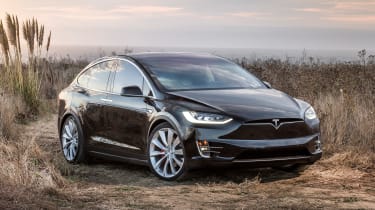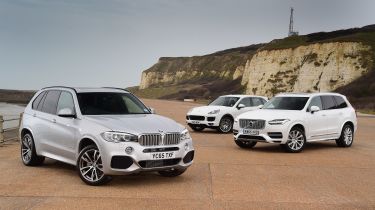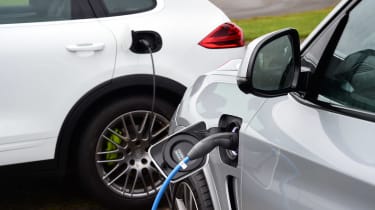BMW X5 vs Porsche Cayenne vs Volvo XC90
BMW’s new plug-in hybrid X5 joins a new breed of cleaner SUVs. Can it beat Volvo and Porsche rivals?
Say the words ‘full-sized SUV’ to most people, and a vision is likely to spring to mind of a gas-guzzling 4x4 that’s either stopped outside the school gates or at a petrol station.
However, the idea that full-size SUVs are big, thirsty machines is being challenged by a new breed of model that incorporates the latest plug-in hybrid technology. In this test, we’ve lined up a couple of recent arrivals to take on a hybrid pioneer.
• Best 4x4s and SUV to buy right now
First up is the BMW X5e. It’s based on the standard X5, but is fitted with a petrol-electric drivetrain that promises a range of 19 miles on battery power alone.
But that’s not as far as our second contender claims to go. The Volvo XC90 T8 Twin Engine has an official range of up to 27 miles, as well as lower overall CO2 emissions than the BMW. Trouble is, it’s also more expensive than its rival.
Both of these cars will have to be at the top of their game to beat one of the first plug-in SUVs on the market: the Porsche Cayenne E-Hybrid. It has a power advantage, but does that mean a compromise when it comes to efficiency?
Used - available now
We put all three through their paces to see if they offer the best of both worlds.
Head-to-head
Charging
All three cars can be charged from the mains, and if you want to recharge on the move, you can set them to harvest energy back into the battery by using the engine as a generator.
You can also save the charge for use later, while the X5 can optimise the best time to use the electricity supply if you have set a destination in the sat-nav.
Boot space
The XC90 has the biggest boot here, but all three models are compromised by their hybrid drivetrains. In five-seat mode, the Volvo provides 640 litres (compared to 775 litres in the standard XC90), while the Cayenne loses 38 litres and the X5 is down to 500 litres.
Plug-in discounts
None of these cars qualifies for the Government’s Plug-in Car Grant – the X5 has emissions over 75g/km, while the other two break the £60,000 price threshold. All three makers provide discounts on fast charging points, though.
Verdict
First place: Volvo XC90
The XC90 takes victory, with a major caveat. It wins thanks to its low company car tax rate, surprising straight-line pace and first-class cabin, but the Twin Engine only makes sense if you can charge it every time you park it. If you don’t, fuel economy will only be slightly better than the T6 petrol, and the small tank means you’ll fill it up more often. For most buyers, the D5 diesel is a better option.
Second place: Porsche Cayenne
Like the XC90, the Cayenne E-Hybrid only makes sense if you can plug it in to maximise the amount of electric running you can do, and a regular model may be more suitable for your needs. It’s not the most efficient hybrid around, and it can get expensive pretty quickly if you rack up the options, but it beats the X5 for performance, handling and practicality.
Third place: BMW X5
Compared to its rivals, the X5 40e can be viewed as reasonably good value, although that £57k price tag is still steep. Unfortunately, adding a hybrid drive system hasn’t done anything to improve the standard X5 driving experience, and it still suffers from the same compromised handling and uncomfortable ride. It’s not a giant leap in terms of efficiency, either.
Is it worth waiting for this model?
Tesla Model X

Due: Summer Price: £65k (est)Engine: 70kWh electric motor
As well as a radical rear door layout and all-electric power, the Model X will offer seven seats and searing straight-line performance. Plug it into a Tesla Supercharger, and it’ll charge to 80 per cent capacity in only 40 minutes.
Figures
| Volvo XC90 T8 Twin Engine Momentum | Porsche Cayenne S E-Hybrid | BMW X5 xDrive40e M Sport | |
| On the road price/total as tested | £60,455/£72,230 | £62,154/£73,413 | £56,705/£61,615 |
| Residual value (after 3yrs/36,000) | £26,056/43.1% | £25,732/41.4% | £25,517/45.0% |
| Depreciation | £34,399 | £36,422 | £31,188 |
| Annual tax liability std/higher rate | £846/£1,691 | £1,863/£3,726 | £1,700/£3,399 |
| Annual fuel cost (12k/20k miles) | £1,697/£2,828 | £2,500/£4,167 | £2,143/£3,572 |
| Ins. group/quote/road tax band/cost | 42/£1,047/A/£0 | 49/£1,334/A/£0 | 42/£1,007/A/£0 |
| Cost of 1st/2nd/3rd service | £1,001 (3yrs/54k) | £420/£490/£420 | £575 (5yrs/50k) |
| Length/wheelbase | 4,950/2,984mm | 4,855/2,895mm | 4,886/2,933mm |
| Height/width | 1,776/2,008mm | 1,705/1,939mm | 1,762/1,938mm |
| Engine | 4cyl in-line/1,969cc | V6/2,995cc | 4cyl in-line/1,997cc |
| Combined peak power/revs | 401/5,700 bhp/rpm | 410/5,500 bhp/rpm | 309/5,000 bhp/rpm |
| Combined peak torque/revs | 640/2,200 Nm/rpm | 590/1,250 Nm/rpm | 450/1,250 Nm/rpm |
| Electric motor | 87bhp | 111bhp | 94bhp |
| Transmission | 8-spd auto/4WD | 8-spd auto/4WD | 8-spd auto/4WD |
| Fuel tank capacity/spare wheel | 50 litres/repair kit | 80 litres/repair kit | 85 litres/run-flats |
| Boot capacity (7/5/2 seat modes) | 262/640/1,816 litres | N/A/580/1,690 litres | N/A/500/1,720 litres |
| Kerbweight/payload/towing weight | 2,296/689/2,400kg | 2,350/700/3,500kg | 2,230/750/2,700kg |
| Turning circle/drag coefficient | 11.9 metres/0.29Cd | 11.9 metres/0.36Cd | 12.7 metres/0.31Cd |
| Basic warranty (miles)/recovery | 3yrs (60,000)/3yrs | 3yrs (unltd)/3yrs | 3yrs (unlimited)/3yrs |
| Service intervals/UK dealers | 18k miles (1yr)/109 | 20k miles (2yrs)/36 | Variable/153 |
| Driver Power manufacturer/dealer pos. | 17th/22nd | 6th/8th | 13th/23rd |
| NCAP: Adult/child/ped./assist/stars | 97/87/72/100/5 | N/A | N/A |
| 0-60/30-70mph | 5.7/5.1 secs | 5.5/4.5 secs | 6.7/6.0 secs |
| 30-50mph in 3rd/4th | 2.2 secs (kickdown) | 3.0/3.9 secs | 2.3 secs (kickdown) |
| 50-70mph in 5th/6th/7th/8th | 2.9 secs (kickdown) | 4.6/5.7/7.3/9.3 sec | 3.7 secs (kickdown) |
| Top speed/rpm at 70mph | 140mph/2,000rpm | 150mph/1,800rpm | 130mph/1,700rpm |
| Braking 70-0/60-0/30-0mph | 62.9/38.9/10.6m | 46.6/36.5/12.1m | 58.3/33.9/10.7m |
| Noise outside/idle/30/70mph | 63/43/57/69dB | N/A/N/A/61/68dB | 65/44/58/69dB |
| Auto Express econ (mpg/mpl)/range | 33.6/7.4/370 miles | 22.8/5.0/401 miles | 26.6/5.9/497 miles |
| Govt combined/weighted economy | 52.5/104.6mpg | 83.1/83.1mpg | 35.9/83.1mpg |
| Govt combined/weighted economy | 11.5/23.0mpl | 18.3/18.3mpl | 7.9/18.3mpl |
| Actual/claimed CO2/tax bracket | 194/49g/km/7% | 286/79g/km/15% | 245/78g/km/13% |
| Airbags/Isofix/self parking/camera | Seven/y/£650/£400 | Six/yes/no/£446 | Six/yes/£300/£375 |
| Auto box/stability/adaptive cruise | Yes/yes/yes | Yes/yes/£1,287 | Yes/yes/£1,330 |
| Climate control/leather/heated seats | Yes/yes/yes | Yes/£2,177/£296 | Yes/yes/yes |
| Metallic paint/LEDs/power tailgate | £700/yes/yes | £720/£1,886/yes | Yes/£1,495/yes |
| Sat-nav/USB/DAB radio/Bluetooth | Yes/yes/yes/yes | Yes/yes/£324/yes | Yes/yes/yes/yes |















